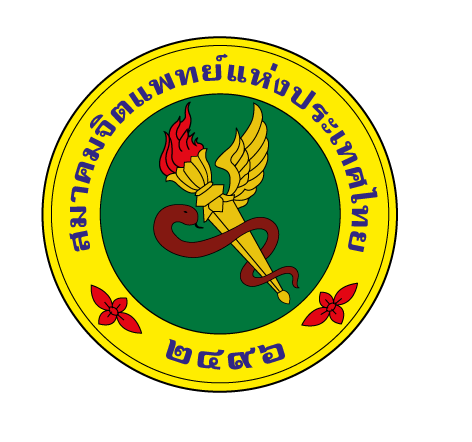การศึกษานำร่องผลของกลุ่มบำบัดแบบเจริญสติ ต่อกระบวนการคิดขั้นสูงในนักเรียนชั้นประถมศึกษา
Main Article Content
บทคัดย่อ
วัตถุประสงค์ เพื่อพัฒนาเครื่องมือและวัดผลของโปรแกรมกลุ่มบำบัดแบบเจริญสติเพื่อเพิ่มกระบวนการ คิดขั้นสูง
ในนักเรียนชั้นประถมศึกษา
วิธีการศึกษา ทำการทดลองในนักเรียนชั้นประถมศึกษาปีที่ 4 ของโรงเรียนรัฐบาลแห่งหนึ่งใน กรุงเทพมหานคร จำนวน 2 ห้องเรียนห้องเรียนละ 27 ราย โดยเลือกแบบเฉพาะเจาะจงในห้องเรียนที่ เป็นกลุ่มทดลอง เพื่อเข้าร่วมโปรแกรมกลุ่มบำบัดแบบเจริญสติและเลือกอีก1ห้องเรียนที่มีจำนวนนักเรียน เท่ากันมาเป็นกลุ่มควบคุมโปรแกรมกลุ่มบำบัดแบบเจริญสติประกอบด้วยกิจกรรมกลุ่มสัปดาห์ละ 1 ครั้ง ครั้งละ 1 ชั่วโมง จำนวน 8 สัปดาห์ติดต่อกัน ใช้เวลาในชั่วโมงแนะแนว ผลลัพธ์ที่ต้องการวัด คือ กระบวนการคิดขั้นสูงที่วัดโดย teacher-rated executive function scale (EFS-T) ซึ่งจะประเมินความ สามารถในด้าน metacognition, emotional regulation และ behavioral regulation โดยประเมินก่อน เริ่มทำกิจกรรมครั้งแรกและหลังจบกิจกรรมครั้งสุดท้ายทันที จากนั้นนำความแตกต่างของคะแนนจาก EFS-T ในแต่ละกลุ่มมาวิเคราะห์ทางสถิติ
ผลการศึกษา นักเรียนกลุ่มที่เข้าร่วมโปรแกรมกลุ่มบำบัดแบบเจริญสติ มีการพัฒนาของคะแนนประเมิน EFS-Tเทียบก่อนและหลังทำกิจกรรมมากกว่ากลุ่มควบคุม ทั้งด้าน metacognition, emotional regulation, behavioral regulation และคะแนนรวมกระบวนการคิดขั้นสูงโดยผลความแตกต่างของ คะแนน EFS-Tด้าน metacognition กลุ่มบำบัดแบบเจริญสติ เป็น 9.37 (SD=4.15) กลุ่มควบคุม เป็น 0.63 (SD=3.50) p<0.005 ด้าน emotional regulation กลุ่มบำบัดแบบเจริญสติ เป็น 12.30 (SD=6.31) กลุ่มควบคุม เป็น 4.25 (SD=5.07) p<0.005 ด้าน behavioral regulation กลุ่มบำบัดแบบเจริญสติ เป็น 9.00 (SD=5.80) กลุ่มควบคุม เป็น -0.89 (SD=2.81) p<0.005 และ total score กลุ่มบำบัดแบบเจริญ สติ เป็น 10.70 (SD=4.65) กลุ่มควบคุม เป็น 1.59 (SD=3.08) p<0.005
สรุป โปรแกรมกลุ่มบำบัดแบบเจริญสติอาจเป็นเครื่องมือการบำบัดแบบกลุ่มที่มีผลในการช่วยพัฒนา กระบวนการคิดขั้นสูง ในนักเรียนชั้นประถมศึกษา
Article Details
บทความที่ส่งมาเพื่อพิจารณา ต้องไม่เคยตีพิมพ์หรือได้รับการตอบรับให้ตีพิมพ์ในวารสารฉบับอื่น และต้องไม่อยู่ระหว่างการส่งไปพิจารณาในวารสารอื่น
เอกสารอ้างอิง
Diamond A. Executive functions. Annu Rev Psychol 2013; 64: 135-68.
Jacobson LA, Williford AP, Pianta RC. The role of executive function in children’s competent adjustment to middle school. Child Neuropsychol 2011; 17: 255-80.
Barkley RA, Grodzinsky G, DuPaul GJ. Frontal lobe functions in attention deficit disorder with and without hyperactivity: A review and research report. J Abnorm Child Psychol 1992; 20: 163-88.
Barkley RA. Behavioral inhibition, sustained attention, and executive functions: constructing a unifying theory of ADHD. Psycho Bull 1997; 121: 65.
Shallice T, Marzocchi GM, Coser S, Del Savio M, Meuter RF, Rumiati RI. Executive function profile of children with attention deficit hyperactivity disorder. Dev Neuropsychol 2002; 21: 43-71.
Brown TE, Landgraf JM. Improvements in executive function correlate with enhanced performance and functioning and health-related quality of life: evidence from 2 large, double-blind, randomized, placebo-controlled trials in ADHD. Postgrad Med 2010; 122: 42-51.
Baler RD, Volkow ND. Drug addiction: the neurobiology of disrupted self-control. Trends Mol Med 2006; 12: 559-66.
Denson TF, Pedersen WC, Friese M, Hahm A, Roberts LJP, Bulletin SP. Understanding impulsive aggression: Angry rumination and reduced self-control capacity are mechanisms underlying the provocation-aggression relationship. Pers Soc Psychol Bull 2011; 37: 850-62.
Taylor HG, Clark CA. Executive function in children born preterm: Risk factors and implications for outcome. Seminars in perinatology. Semin Perinatol 2016; 40: 520-9.
Polanczyk G, De Lima MS, Horta BL, Biederman J, Rohde LA. The worldwide prevalence of ADHD: a systematic review and metaregression analysis. Am J Psychiatry 2007; 164: 942-8.
Visanuyothin T, Pavasuthipaisit C, Wachiradilok P, Arunruang P, Buranasuksakul T. The prevalence of attention deficit/hyperactivity disorder in Thailand. Journal of Mental Health of Thailand 2013; 21: 66-75.
Siegel LS, Ryan EB. The development of working memory in normally achieving and subtypes of learning disabled children. Child Dev 1989; 60: 973-80.
Barkley RA, McMurray MB, Edelbrock CS, Robbins KJ. Side effects of methylphenidate in children with attention deficit hyperactivity disorder: a systemic, placebo-controlled evaluation. Pediatrics 1990; 86: 184-92.
Diamond A, Lee K. Interventions shown to aid executive function development in children 4 to 12 years old. Science 2011; 333(6045): 959-64.
Hölzel BK, Lazar SW, Gard T, Schuman-Olivier Z, Vago DR, Ott UJ. How does mindfulness meditation work? Proposing mechanisms of action from a conceptual and neural perspective. Perspect Psychol Sci 2011; 6: 537-59.
Lu S, Huang C, Rios JJ, Review YS. Mindfulness and academic performance: An example of migrant children in China. Child Youth Serv Rev 2017; 82: 53-9.
Flook L, Smalley SL, Kitil MJ, Galla BM, Kaiser- Greenland S, Locke J, et al. Effects of mindful awareness practices on executive functions in elementary school children. J Appl Sch Psychol 2010; 26: 70-95.
McCloskey LE, Sciences B. Mindfulness as an intervention for improving academic success among students with executive functioning disorders. Procedia Soc Behav Sci 2015; 174: 221-6.
Cairncross M, Miller CJ. The effectiveness of mindfulness-based therapies for ADHD: a meta-analytic review. J Atten Disord (journal on the internet) 2016 Feb 2 [cited 2019 Dec 18]. doi: 10.1177/1087054715625301. (Epub ahead of print)
Anantavorawong S, Narkpongphun A, Health M. The effects of a mindfulness therapy program on core symptoms of children with ADHD disorder. International Journal of Child Developmental and Mental Health 2018; 6: 40-55.
Saengsawang T, Langka W, Utairatanakit D, Semheng S. A development of executive function skills indicators for elementary students. BU Academic Review 2016; 15: 14-28.

